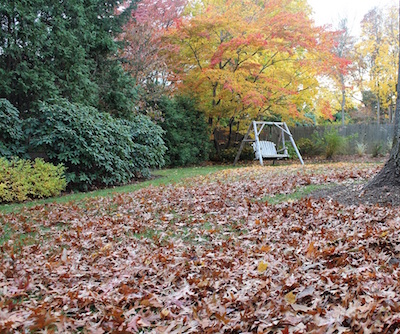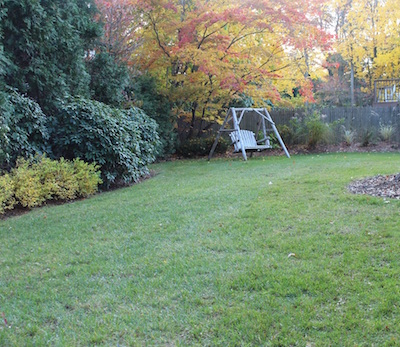This Fall, Mow (Don’t Blow) Your Leaves
- Wednesday, 26 September 2018 11:04
- Last Updated: Thursday, 27 September 2018 13:13
- Published: Wednesday, 26 September 2018 11:04
- Conservation Advisory Council
- Hits: 4980
 Lawn Before Leaf Mulch MowingMowing your leaves - also known as mulch mowing - into tiny pieces on your lawn, is healthier for your lawn and soil than piling or bagging them to be removed. As the shredded leaves decompose, their nutrients enhance the soil and provide free organic mulch for your garden beds. The pollutants from leaf blowers and trucks are avoided. Homeowners around Scarsdale have been mulch mowing leaves for many years with great results.
Lawn Before Leaf Mulch MowingMowing your leaves - also known as mulch mowing - into tiny pieces on your lawn, is healthier for your lawn and soil than piling or bagging them to be removed. As the shredded leaves decompose, their nutrients enhance the soil and provide free organic mulch for your garden beds. The pollutants from leaf blowers and trucks are avoided. Homeowners around Scarsdale have been mulch mowing leaves for many years with great results.
Mulch mowing can be done with any standard lawn mower or commercial lawn mower with a mulching blade. Simply mow over the fallen leaves. All landscapers have the equipment to mulch mow, and it is just as easy (or easier) to mulch mow than it is to blow the leaves to the curb. If you find that you have excess leaves, place the mulched leaves in your garden beds. They look great, are a healthy addition to your yard and will save you the cost of buying wood mulch. Remember, to avoid damaging trees and plants, never place mulch directly against a tree trunk or shrub and never pile mulch more than 2”-3” high in a garden bed.
The following sections provide additional details on what mulch mowing is and how to do it.
What is leaf mulch mowing?
Leaf mulch mowing is the process of using a lawn mower to shred leaves into small pieces that are left on the lawn or spread on  Lawn After Leaf Mulch Mowinggarden beds and around shrubs. The shredded leaves quickly settle between grass blades and decompose to provide natural nutrients to the soil. Leaf-mulched lawns often need less fertilizer and water. Excess mulch can be blown into garden beds to help prevent weed growth, to conserve moisture and sprinkler usage, and to provide a protective layer in winter.
Lawn After Leaf Mulch Mowinggarden beds and around shrubs. The shredded leaves quickly settle between grass blades and decompose to provide natural nutrients to the soil. Leaf-mulched lawns often need less fertilizer and water. Excess mulch can be blown into garden beds to help prevent weed growth, to conserve moisture and sprinkler usage, and to provide a protective layer in winter.
Why is mulch mowing more beneficial than piling leaves at the curb for the Village to pick up?
Mulching leaves adds organic material to your lawn and plant beds which improves the soil. Mulch mowing also reduces the number of truck trips necessary to pick up and haul leaves away, reduces the use of leaf blowers and gets large piles of leaves off our streets.
How do I mulch mow my leaves? Is special equipment needed?
Leaf mulch mowing can be done with a standard homeowner or commercial lawn mower. To help shred the leaves into smaller pieces, it’s recommended that a mulching blade be used. This type of blade, which has grooves to shred the leaves, is inexpensive and available for any type of mower.
Do landscapers mulch mow leaves?
Yes. If you use a landscaper, ask them to mulch mow your leaves instead of blowing the leaves into a pile at the curb. Many, but not all, landscapers have experience mulch mowing leaves. If your landscaper is new to mulch mowing, the following are key points for them to know:
Equipment: They should use a mulching blade at a minimum, but a mulching kit will provide even better results. Mulching kits, which include additional attachments beyond just a mulching blade, are available at any mower distributor and can be fitted to commercial mowers.
Mulching Technique: Mowing the leaves in a circular pattern, rather than back and forth in lines, will result in smaller pieces of leaves which decompose more quickly and will avoid “striping lines.”
Time: It should take your landscaper no additional time to mulch mow leaves rather than blowing them to the curb. In many cases it actually saves time.

Yes. If you mow your own lawn, use a mulching blade which you can install yourself or bring to any local mower shop (there is one in downtown Scarsdale) to install. Make sure to have the blade sharpened as needed. Try to mulch leaves once a week so the piles don’t build up too high for your mower, especially during the heavy drop of leaves. For larger amounts of leaves, you may want to raise the height of the mower deck.
Will mulch mowing cost more?
Mulch mowing leaves should not cost more than having leaves blown to the curb or bagged. There are many landscapers in Scarsdale who have been mulch mowing properties for years at no additional cost. If your landscaper claims it will be more time consuming, ask them to try it for a few weeks. They should see it takes no additional time.
Can all types of leaves be mulch mowed?
Yes! All types of leaves can be mulch mowed.
Pine needles, which are acidic, may change the ph balance of your lawn if mulch mowed in large quantities. Consider using pine needles as a mulch around the base of pine trees.
Will the shredded leaves harm my lawn or make it look messy?
The shredded leaves will not harm your lawn. In fact, the shredded leaves are beneficial to your lawn. Decomposing leaves cover the soil between the individual blades of grass where weeds can germinate. Once the small bits of leaves settle in, microbes and worms start breaking them down. It is important that the leaves are shredded because whole leaves left on a lawn can smother the grass. The shredded leaves quickly settle into the lawn and your lawn should not look messy.
What if I have too many leaves?
Shredding piles of leaves reduces the volume of leaves significantly! What looks like a huge leaf pile will shred into tiny pieces and quickly settle into your lawn. Excess shredded leaves can also be used as mulch in your garden beds.
If you are concerned about the quantity of leaves, try mulch mowing for a few weeks when leaves first begin to fall and there is less leaf volume. Even if you need to put some leaves to the curb during the heavy leaf drop, any reduction in leaves put to the curb is a benefit.
Leaf mulch mowing benefits our local landscape, reduces the number of truck trips in our community and gets large piles of leaves off the streets.
Leaf Mulch Mowing Resources
Mulch mowing tutorial: Link
Education panel with landscapers and representatives from Cornell Cooperative Extension: Link
Overview of Mulch Mowing Benefits with Chip Osborne (Organic Landscaping Consultant used by the Village on Parks and Fields): Link
Love ‘Em and Leave ‘Em Mulch Mowing Initiative: Link
This article is the second in a series of sustainability articles published by the Scarsdale CAC. To read previous articles, please visit the CAC website at CAC Page.
To contact members of the CAC with any questions, email ScarsdaleCAC@gmail.com or send a message with the online form.